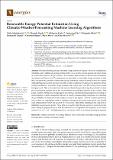Renewable Energy Potential Estimation Using Climatic-Weather-Forecasting Machine Learning Algorithms
Author(s)
Maduabuchi, Chika; Nsude, Chinedu; Eneh, Chibuoke; Eke, Emmanuel; Okoli, Kingsley; Okpara, Emmanuel; Idogho, Christian; Waya, Bryan; Harsito, Catur; ... Show more Show less
Downloadenergies-16-01603-v2.pdf (25.20Mb)
Publisher with Creative Commons License
Publisher with Creative Commons License
Creative Commons Attribution
Terms of use
Metadata
Show full item recordAbstract
The major challenge facing renewable energy systems in Nigeria is the lack of appropriate, affordable, and available meteorological stations that can accurately provide present and future trends in weather data and solar PV performance. It is crucial to find a solution to this because information on present and future solar PV performance is important to renewable energy investors so that they can assess the potential of renewable energy systems in various locations across the country. Although Nigerian weather provides favorable weather conditions for clean power generation, there is little penetration of renewable energy systems in the region, since over 95% of the power is fossil-fuel-generated. This is because there has been no detailed report showing the potential of clean power generation systems due to the dysfunctional meteorological stations in the country. This paper sought to fill this knowledge gap by providing a machine-learning-inspired forecasting of environmental weather parameters that can be used by manufacturing companies in evaluating the profitability of siting renewable energy systems in the region. Crucial weather parameters such as daily air temperature, relative humidity, atmospheric pressure, wind speed, and rainfall were obtained from NASA for a period of 19 years (viz. 2004–2022), resulting in the collection of 6664 high-resolution data points. These data were used to build diverse regressive neural networks with varying hyperparameters to find the best network arrangement. In summary, a low mean-squared error of 7 <inline-formula><math xmlns="http://www.w3.org/1998/Math/MathML" display="inline"><semantics><mrow><mo>×</mo></mrow></semantics></math></inline-formula> 10<sup>−3</sup> and high regression correlations of 96% were obtained during the training.
Date issued
2023-02-05Department
Massachusetts Institute of Technology. Department of Nuclear Science and EngineeringPublisher
Multidisciplinary Digital Publishing Institute
Citation
Energies 16 (4): 1603 (2023)
Version: Final published version